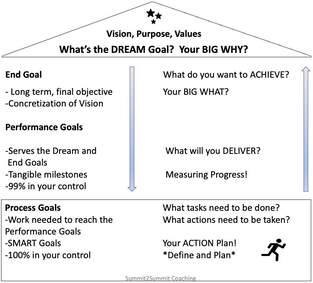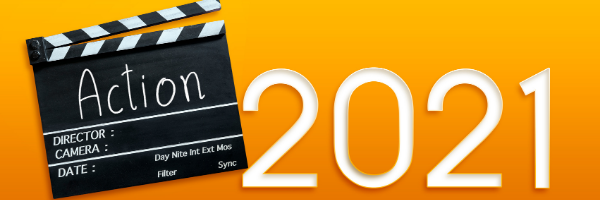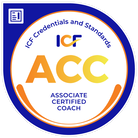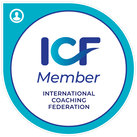 In this unpredictable and dynamic world, the implications for leadership of self and others requires both adaptability and agility. As we turn the corner into 2021 and set out our goals, how can we prepare to shift our mindsets and to think of all possibilities and opportunities? What are the processes and challenges of successful goal attainment in this environment for both ourselves and those we lead or coach? To answer these questions, I’m going fall back on many years in elite sport as an athlete and coach to highlight an approach I’ve learned through sport and one that I’ve used throughout my career and life. I’ve always visualized this process as building my “dream house” so I created a graphic (Fig. 1) that draws from the GROW and SMART models and my own experiences in this journey as a top performer. This is a multi-level, long-term approach that supports a process of action and feedback which can adapt and change course and yet not lose sight of the Big Dream over time. The roof is our Big Dream (our Big Why?), serves as inspiration and is aligned with our purpose and values. At the foundation are our process goals that support the tasks and actions needed to reach the higher-level goals. Our performance or milestone goals sit on the first floor and our end goals (our Big What?) are on the second floor. Performance (mid-term) goals serve the end goals, are tangible milestones that measure our progress and are 99% in our control. An example of a performance goal for an athlete is to be selected to the World Championship team at a specified time in the planning of becoming an Olympian, the end goal and the dream. The process goals (short term tasks) serve the performance goals and are 100% in our control. This is the day to day work we need to focus on to reach our milestones, the measure of our progress. Staying on track and keeping aligned to our vision, purpose and values requires a good feedback loop (blue shaded arrows) in order to tweak the plan. It’s important to remember that goals can or will change too. Sometimes cutting our losses and changing course will save us time, money and energy. High Level Goals and the Importance of Purpose and Inspiration When we have a higher purpose in mind and it’s shared by others, succeeding and leading is easier. With purpose, setting goals is easier and we find the courage to face new challenges. When we are serving our purpose, we are engaged in meaningful work, feel fulfilled and that feeds our happiness along the way. When our Big Dream tops and tails our end and performance goals it serves our inspiration. This is a key to driving our efforts and engagement over time. Rallying ourselves and our teams around the shared dream, purpose and values is vital for success. Inspiration from our Big Dream ignites action, taking on greater challenge and growth! And our commitment to action speaks to how much we are willing to invest in the process, the efforts we put in. Big disruptions will also cause major shifts in our plan or require a new plan altogether. We can always find solutions to adapt and align a new plan to our purpose and keep going. “I learned way more from how I faced the challenge of chaos and change than anything else, and now instead of Olympic prep, I’m talking about maintaining focus when the plan you had went out the window. Your destination may be the same, but the path to get there is going to be different. Don’t just accept the changes, begin anticipating them. Change or be changed… Envision your new path. Let it be simple at first, fill it out as things progress.” -Marnie McBean, Canadian rower, 4 x Olympic medalist and Chef de Mission Tokyo 2020 in her May Blog “Chaos and Change can provide the greatest opportunities”. In any journey, our dream may remain the same, but goals may have to adapt to disruption and a new reality, a new plan needs to emerge. At the ground level, what are the characteristics of the process goals? The short-term tasks and actioning that must be adaptable and flexible? Building for Success: Process Goals = SMART Goals In this system, process goals will be characterized using the SMART goal model. Our process goals are the short-term tasks we take action on defined as: S Specific: The more specific the easier to achieve it. M Measurable: Know when you have achieved your goal. A Adjustable: How will the action plan be adjustable? R Realistic: Are goals challenging and inspirational? T Timebound: What are your deadlines on a timeline? We must set our goal levels for success: have we set minimum, target, and extraordinary goal levels? Our goals can vary on time, quantity and quality and we must test our assumptions and be open to input and seek input. “Goals should be realistic, but achievable with effort. If no or low effort is required, your goal is not inspirational or engaging enough” – Lou Lukanovich, Canadian kayak sprinter, 3 x Olympian, Order of Canada Any goal setting process must include our best understanding of the effort required, challenges and obstacles to success. Making a list and being honest and realistic serves our best interests and helps to avoid setting dysfunctional goals, fomenting procrastination, additional stress and anxiety to ourselves and those we lead. Other important questions to ask are what resources do I/we need and what is available? People, things, personal qualities, knowledge, skills, finance, technology, admin? Write it all down and document it. It is important for our intentions and commitment to write down our goals and create a plan of action to achieve our goals, no matter how big or small. All of these considerations must be finalized into our plan. In the world of elite sport this will be a “Yearly Training Plan” or YTP that covers the macro down to the micro cycles and how hours of training and preparation are allocated: • Timelines and deadlines are established and committed to. • Performance milestones. • A mechanism to review, align and tweak the plan on an ongoing basis. To move into action, what are the tasks with the short-term actions of 1-2 weeks? What is the first action you will take? Starting when? Then write it down. “I find one of the most successful ways of transforming my goals into action is simply to write them down. Having your goals regularly visible makes you much more accountable and therefore likely to follow through with the actions you need to achieve them” – Mark Oldershaw, Canadian sprint canoeist, 3 x Olympian and bronze medalist Goals and Visualization What really helps with goal attainment is visualizing the process of getting to our goal. Neuroscience research informs us that visualizing successes or wins is wishful thinking, fantasizing even and can hinder progress. When we visualize the various steps to take in the process, and our measures of success, we reduce anxiety and facilitate the planning process. For example, an athlete should focus on visualizing the successful execution of their race plan not standing on the podium. Visualizing the steps of getting to a goal is what propels our progress. Goals and Motivation Because whatever we put our attention on grows, we want our goals to be stated in the positive. We also want clarity around WHY we want to achieve a goal, the purpose and meaning around any goal large or small. Questions we can ask ourselves include: • what are all the benefits of achieving the goal (intrinsic/extrinsic); • what is the big benefit? • What other areas will benefit from achieving this goal? • Rewards for accomplishment? • What is the opportunity cost of not achieving the goal? The answers to these questions help move us into the positive actions needed to complete tasks that, once completed successfully, will fuel our motivation to continue onto the next tasks. Breaking down our goals into smaller chunks or tasks helps with motivation as successful completion of a task no matter how small will also fuel motivation and reduce overwhelm. So, make your tasks small enough to win at. “If it will take you more than one week to achieve your goal, break it into intermediate steps so that you feel you are in control and are making progress.” – Lou Lukanovich, Canadian kayak sprinter, 3 x Olympian, Order of Canada Progress in meaningful work no matter how small will get us into our progress loop where progress and a positive inner work life fuel each other into an upward spiral. This is referred to as the “Progress Principle” and includes not just significant progress but small progress can lead to big wins too! Being in good health and having a balanced physiology or “body budget” in order to carry out this work is also vital to achieving our higher-level goals. We need sufficient energy to take action, feel positive and perform at our best over time! Goals and a Learning Mindset A key success factor to achieving our goals is how we will “show up” every day. This is a term we use often with our athletes in sport coaching and applies well to any goal pursuit. How we “show up” speaks to our engagement in the process that we have committed to. Important questions we need to ask ourselves here are: • How you will need to be different? • How will you have to look at or do things differently? • Start doing something? • Stop doing something? It really helps to have a learning or “growth” mindset in any goal setting process. We may have to learn new things, develop new habits, adapt to change and disruption and build resilience to the impact of factors beyond our control. With a growth mindset the belief is that talents and abilities can be developed though effort, teaching and persistence and that we learn from our mistakes. This mindset also increases engagement and the longevity of relationships. So, we need to ask ourselves “who do I need to be to make this happen?” Understanding that “I will need to be someone who is _____________”, and fill in the blank. Goals and the Journey What really matters at all times? The journey. Neuroscience research indicates that the journey to mastery is what really matters to us, more than the actual results or achievement of mastery. Whatever purpose we set, the journey towards reaching our goals should provide happiness and meaning more than actually reaching our goals ever can. The thrill of crossing the finish line fades while the memory of the trip lasts a lifetime. The following is a powerful quote from a great Canadian athlete and Hall of Famer, that illustrates the science and my own experiences as well in sport, business and life. “There is no magic to success. Surround yourself with an awesome team that believes in you and the project. Give it everything you’ve got. In the end it’s the journey not the result that matters so make it a good ride!” – Sue Holloway, Canadian kayak sprinter, xc skier, 4 x Olympian, 2 x Olympic Medalist. So, what are the ingredients for a happy, meaningful and successful goal attainment journey for us and others? Here are a collection of mindsets and approaches that we can adopt. Goals and Leadership of Self and Others Adopting a growth mindset is key and allows us to focus on the process and the power of “yet”. As in “we are not there yet, we are learning, we will get there”. Embracing the power of “yet” sets the tone and ensures that we will continue the practice with the persistence, efforts and resilience required to reach our goals. Be curious and flexible. As leaders we can leverage the power of “not knowing”. This opens opportunities and for others to contribute more to the efforts. Belief in self and others. This speaks to our own confidence and ability to be confident in others. Confidence shows up when we focus on the journey to mastery. Confidence is also nurtured through action learning and being willing to take calculated risks Hope and compassion allow us to ask how we can best serve ourselves and others. And this enhances our feelings of value, meaning and purpose. Maintaining a positive inner work life is also essential for a happy journey and enhances our sense of contributing valuable work to the process for both ourselves and those we lead. Openness and ethics in the process. Are values stated clearly and understood by all stakeholders? Trust is critical for success and this requires we ensure an open and inclusive process of input and feedback at every stage of the journey. Wrap up Polarity is always at work in our lives and world around us. How we respond will determine the direction our journey will take. Setting clear goals and transforming our goals into well thought out planning and actions is a practice that will bring clarity and confidence to our leadership of self and others at all times, not just during disruptive times. Highlighting a multi-level goal setting approach, that supports a process of action and feedback illustrates how we can adapt and change course and remain inspired while not losing sight of the big dream and purpose through the process. For ourselves, those we lead or coach, this is a journey characterized by a growth mindset, curiosity, nurturing confidence and building a positive inner work life that keeps us motivated and engaged; enhances our joy in the process; maintains our efforts and commitment to performance over time; and builds the resilience we need to overcome our ongoing challenges as we strive to successfully reach our goals and dreams. References On the G.R.O.W. model: “Coaching for Performance” (2017) 5th edition, Sir John Whitmore On S.M.A.R.T. goals: “There’s a S.M.A.R.T way to write management’s goals and objectives” (1981) Doran, G. T. Management Review “Nail That Goal” coaching tool, The Coaching Tools Company “How Remarkable Women Lead” (2009), J. Barsh, S. Cranston, G. Lewis “Chaos and Change can Provide the Greatest Opportunities” (May 2020) Marnie McBean, Chef de Mission for Canada, Tokyo 2020 “The Progress Principle: Using Small Wins to Ignite Joy, Engagement, and Creativity at Work” (2011), T. Amabile, S. Kramer “How to Not Give Up on Your Goals” (April 2020) Dr. Irena O’Brien “Why Procrastination is About Managing Emotions and Not Time” (May 2020), Dr. Christian Jarrett “To Visualize or Not to Visualize: What Works” (April 2018) Dr. Irena O’Brien “What You Focus On Grows Stronger” (2019) Dr. Randy Kamen “Why Visualization Doesn’t Work to make Your Dreams a Reality” (June 2019) Dr. Irena O’Brien “The Willpower Instinct: How Self-Control Works, Why It Matters, and What You Can Do to Get More of It” (2013) K. McGonigal “Mindset: The New Psychology of Success” (2006) Dr. C. Dweck “Mindset: How You Can Fulfill Your Potential” (2012) Dr. C. Dweck “How to Sustain Motivation” (2020) Dr. Irena O’Brien “Indistractable: How to Control Your Attention and Choose Your Life” (2020) N. Eyal “Atomic Habits: An Easy and Proven Way to Build Good Habits and Break Bad Ones” (2018), James Clear “Solving The Procrastination Puzzle” (2013) Dr. T. Pychyl “Rethinking Positive Thinking” (2014) Dr. Gabriele Oettingen “Journey vs. Destination: Motivation Experts Breakdown Which One to Focus on to Reach Your Goals” (February 2020) M. Clifton “Why the Journey is More Important Than the Destination” (May 2015) O. Wyatt “Your Body Budget: 3 Key Self-Care Elements for Strong Healthy Clients” (July 2020) K. Lukanovich On quotes: graciously provided to me by Lou Lukanovich, Mark Oldershaw and Sue Holloway for use in my presentations and articles on goal setting processes.
1 Comment
|
Author
Karen Lukanovich, MBA, ACC, Olympian, Leadership and Performance Coach. Archives
February 2021
Categories
|
Unlock Your Potential!
Schedule a friendly chat
Here to assist you, please reach out by phone, email or via social media channels
Schedule a friendly chat
Here to assist you, please reach out by phone, email or via social media channels
ACC certified by and proud member of the International Coaching Federation (ICF)
www.karenlukanovich.com
www.summit2summitcoaching.com
www.summit2summitcoaching.com




 RSS Feed
RSS Feed

